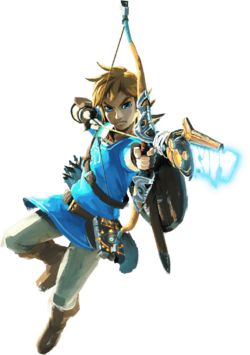
Bow
General Info

| Item Name | Bow |
|---|
Overview
As a long-range weapon, the bow gives Link a means of attacking enemies from afar, especially useful when the enemy is too dangerous to approach or unreachable by other weapons. They can be enchanted with elemental powers such as fire and ice, increasing their utility and dealing more damage to enemies.
In different games, the bow has various upgrade stages with improved properties such as range, power, and significantly increased firing speed. It is often used to solve a number of puzzles, hit distant switches, and retrieve dropped items, highlighting its versatility beyond combat.
The bow also plays an important role in the story of the series, as there are many legendary bows such as the Bow of Light. They are often an integral part of the shortcut quest, needed at different points to reach different areas or defeat certain enemies. This iconic weapon seamlessly blends combat, puzzle-solving, and gameplay storytelling, and is sure to resonate well with fans of the series.
Creation and Development
When the developers came up with Legend of Zelda, they wanted a weapon that challenged players to aim carefully and measure the trajectory of their targets, so they introduced the bow. The inclusion of the bow was originally driven by the game's top-down perspective, which required a long-range weapon. As the series progressed, the arc remained a mainstay and gained importance as the games transitioned to 3D gameplay. In order to improve the player's experience, the developers have enriched the possibilities of the bow with each successive game. In Ocarina of Time, the bow was imbued with magic to create arrows of fire, ice, and light. Wind Waker introduced the hero's bow, which had the power to control the direction of the wind. Twilight Princess saw the implementation of bomb arrows, a testament to the creativity of the game developers.
The remakes of the Legend of Zelda games have seen significant changes to the arc design, with each iteration designed to maintain the consistency and aesthetic of a particular game world. In Breath of the Wild, the bow became a weapon that could be broken and replaced. Different types of bows were scattered throughout the game world, each with unique abilities, turning the bow from one immutable weapon into a versatile and interchangeable asset.
The growth of the Legend of Zelda series arc reflects the player's journey. As players progress, they find stronger options to help them overcome increasingly difficult obstacles. Through its evolution, the arc has cemented its place in the hearts of the series and its fans. Its transformation over time is a testament to the developers' constant desire to improve the game and engage players in new and exciting ways, a legacy they no doubt intend to continue with future installments in the series.
Cultural Impact
Cultural effects extend beyond the games themselves. The bow, like Link's sword, has become a symbol of courage and adventure in popular culture, often appearing on merchandise from t-shirts to key chains, demonstrating the resonance of its meaning with fans around the world. The bow also inspires fan art. In the cosplay community, this is considered an essential part of recreating Link's outfit. This ancient coat of arms also features prominently in the fiction and artwork that reflects its essential role in the canon. In short, the bow isn't just a virtual weapon in the Zelda universe; it's a cultural artifact that represents the franchise's influence on gaming history.